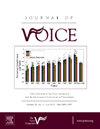关于嗓音音高感知与外部声源音高感知之间可测量差异的研究。
IF 2.5
4区 医学
Q1 AUDIOLOGY & SPEECH-LANGUAGE PATHOLOGY
引用次数: 0
摘要
目标音高感知是准确歌唱的重要组成部分。本研究有两个目标:第一,研究一个人的声音与从外部声源感知到的音高是否存在可测量的差异;第二,测量闭塞对旋律乐句音高准确性的影响。第二,测量闭塞对旋律短语音高准确性的影响:本研究招募了 16 名参与者。旨在调查知觉差异的研究分为两个部分。第一部分是一对一的音高匹配测试,他们将通过唱歌和匹配外部音高来重现音高。第二部分是演唱熟悉的歌曲《生日快乐》,用于测量旋律短语的音高准确性,并测量唱歌时闭塞对音高准确性的影响:一对一研究包括将一系列 5 个音符唱回设定的元音,这 5 个音符与按钮测试中一系列可能的音高匹配时所用的音符相同。旋律测试是唱 3 遍《生日快乐》,第一遍正常,第二遍戴耳机遮住耳朵以减少空气传导听力,第三遍用白噪声掩盖所有听力:结果表明,与使用声音相比,使用外部声音进行音高匹配的准确率更高,而某种形式的遮蔽(戴耳机或耳机加白噪声)显示的版本音高准确率更高:这项研究的结果表明,在比较两种外部声音的音高时,音高的准确性有所提高,而在唱歌时进行某种形式的闭塞也能提高音高的准确性。这可能表明,在重现声音和匹配外部声源之间的音高时存在差异。此外,闭塞耳朵也能提高音准,这进一步说明声音和外部声源在音高感知能力上存在差异。这可能对提高录音室环境中的音高准确性有影响。本文章由计算机程序翻译,如有差异,请以英文原文为准。
An Investigation in the Measurable Differences between Pitch Perception in the Voice and Pitch Perception of External Sound Sources
Objectives
Pitch perception is an important part of accurate singing. Therefore, accurate singing requires the ability to accurately assess the pitch in one's own voice.There are two objectives of this study the first was to investigate whether there is a measurable difference in perceived pitch in one's voice to the pitch one perceives from an external sound source. The second, to measure the effects of occlusion on pitch accuracy over a melodic phrase.
Study Design
We recruited 16 participants for this study. The study that was designed to investigate the perceptual difference was split into two parts. The first is a one-to-one pitch matching test where they would recreate a pitch with singing and matching external pitches. The second was singing the familiar song ‘Happy Birthday’ which was used to measure pitch accuracy over a melodic phrase and to measure the effects of occlusion on pitch accuracy while singing.
Methods
The one-to-one study involved singing back a series of 5 notes to a set vowel which were the same 5 notes used when matching them to a series of possible pitches on the button test. The melodic test was to sing ‘Happy Birthday’ 3 times, the first normally, the second wearing headphones to occlude the ear to reduce air conductive hearing and the third time with white noise to mask all hearing.
Results
The results showed a higher accuracy of pitch matching with external sounds over using their voice, and some form of occlusion (wearing headphones or headphones with white noise) showed the version with higher pitch accuracy.
Conclusions
The results of this study showed that there was improved pitch accuracy when comparing two external sounds in pitch and when singing occlusion of some form improved pitch accuracy. This could suggest a difference when recreating pitch between the voice and matching external sound sources. Furthermore, with the improvements shown from occluding the ears, it could further suggest a difference in pitch perception abilities between the voice and external sound sources. This could have implications of improving pitch accuracy in a studio environment.
求助全文
通过发布文献求助,成功后即可免费获取论文全文。
去求助
来源期刊

Journal of Voice
医学-耳鼻喉科学
CiteScore
4.00
自引率
13.60%
发文量
395
审稿时长
59 days
期刊介绍:
The Journal of Voice is widely regarded as the world''s premiere journal for voice medicine and research. This peer-reviewed publication is listed in Index Medicus and is indexed by the Institute for Scientific Information. The journal contains articles written by experts throughout the world on all topics in voice sciences, voice medicine and surgery, and speech-language pathologists'' management of voice-related problems. The journal includes clinical articles, clinical research, and laboratory research. Members of the Foundation receive the journal as a benefit of membership.
 求助内容:
求助内容: 应助结果提醒方式:
应助结果提醒方式:


